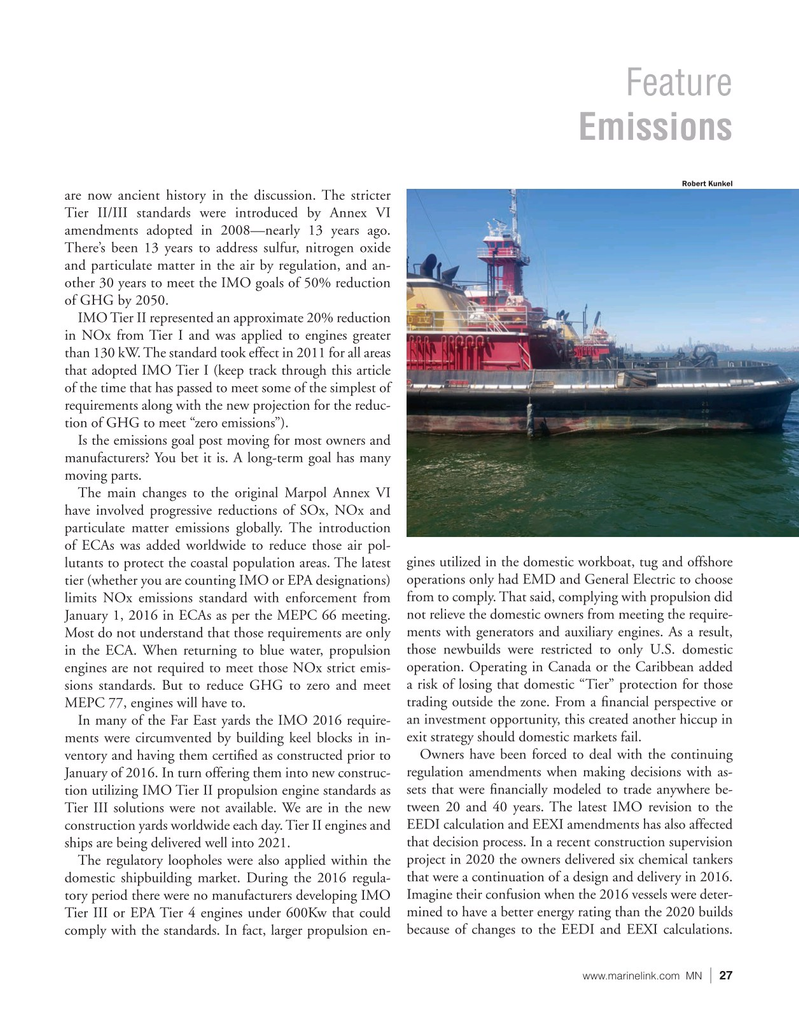
Page 27: of Marine News Magazine (July 2021)
Propulsion Technology
Read this page in Pdf, Flash or Html5 edition of July 2021 Marine News Magazine
Feature
Emissions
Robert Kunkel are now ancient history in the discussion. The stricter
Tier II/III standards were introduced by Annex VI amendments adopted in 2008—nearly 13 years ago.
There’s been 13 years to address sulfur, nitrogen oxide and particulate matter in the air by regulation, and an- other 30 years to meet the IMO goals of 50% reduction of GHG by 2050.
IMO Tier II represented an approximate 20% reduction in NOx from Tier I and was applied to engines greater than 130 kW. The standard took effect in 2011 for all areas that adopted IMO Tier I (keep track through this article of the time that has passed to meet some of the simplest of requirements along with the new projection for the reduc- tion of GHG to meet “zero emissions”).
Is the emissions goal post moving for most owners and manufacturers? You bet it is. A long-term goal has many moving parts.
The main changes to the original Marpol Annex VI have involved progressive reductions of SOx, NOx and particulate matter emissions globally. The introduction of ECAs was added worldwide to reduce those air pol- lutants to protect the coastal population areas. The latest gines utilized in the domestic workboat, tug and offshore tier (whether you are counting IMO or EPA designations) operations only had EMD and General Electric to choose limits NOx emissions standard with enforcement from from to comply. That said, complying with propulsion did
January 1, 2016 in ECAs as per the MEPC 66 meeting. not relieve the domestic owners from meeting the require-
Most do not understand that those requirements are only ments with generators and auxiliary engines. As a result, in the ECA. When returning to blue water, propulsion those newbuilds were restricted to only U.S. domestic engines are not required to meet those NOx strict emis- operation. Operating in Canada or the Caribbean added sions standards. But to reduce GHG to zero and meet a risk of losing that domestic “Tier” protection for those
MEPC 77, engines will have to. trading outside the zone. From a ? nancial perspective or
In many of the Far East yards the IMO 2016 require- an investment opportunity, this created another hiccup in ments were circumvented by building keel blocks in in- exit strategy should domestic markets fail.
ventory and having them certi? ed as constructed prior to Owners have been forced to deal with the continuing
January of 2016. In turn offering them into new construc- regulation amendments when making decisions with as- tion utilizing IMO Tier II propulsion engine standards as sets that were ? nancially modeled to trade anywhere be-
Tier III solutions were not available. We are in the new tween 20 and 40 years. The latest IMO revision to the construction yards worldwide each day. Tier II engines and EEDI calculation and EEXI amendments has also affected ships are being delivered well into 2021. that decision process. In a recent construction supervision
The regulatory loopholes were also applied within the project in 2020 the owners delivered six chemical tankers domestic shipbuilding market. During the 2016 regula- that were a continuation of a design and delivery in 2016. tory period there were no manufacturers developing IMO Imagine their confusion when the 2016 vessels were deter-
Tier III or EPA Tier 4 engines under 600Kw that could mined to have a better energy rating than the 2020 builds comply with the standards. In fact, larger propulsion en- because of changes to the EEDI and EEXI calculations. www.marinelink.com MN 27|

 26
26

 28
28
